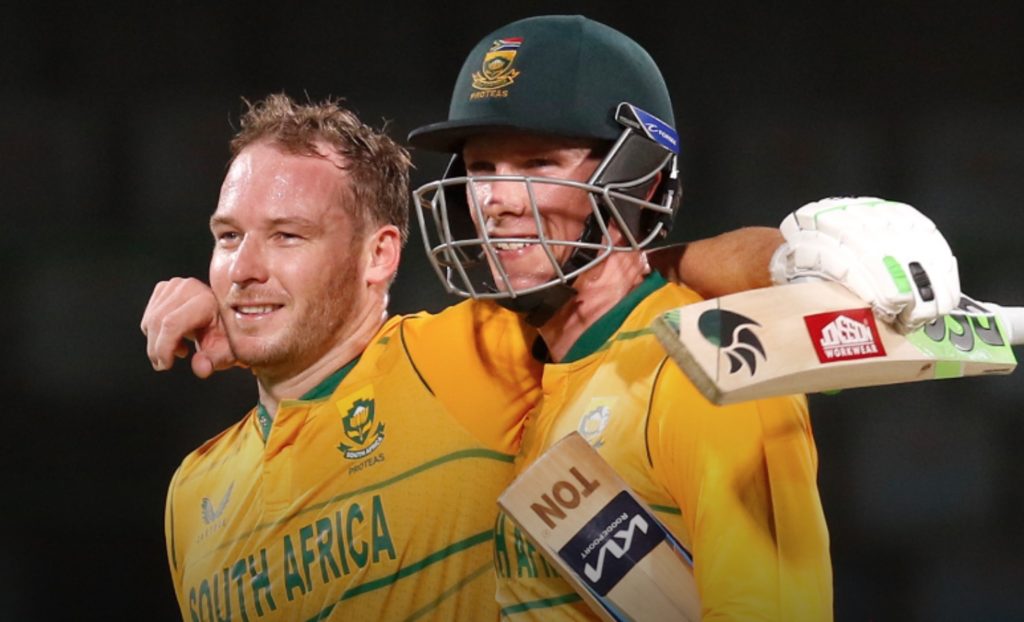Experimentation, composure and execution marked the Proteas’ seven-wicket victory over India, writes RYAN VREDE. Making such performances a defining feature of their identity, and not a once-off, is critical.
The Dehli wicket was planted purely to kill the soul of bowlers, sure. However, the Proteas’ bowlers must reflect on a mediocre showing during which they missed their length on countless occasions. This left their batsmen with a complex assignment, one which they ultimately mastered.
It wasn’t a fluid execution by any means. Quinton de Kock and Dwaine Pretorius, sent in at No 3 to exploit the powerplay, got out when they looked set. Converting these types of starts into match-winning innings is a defining characteristic of the world’s elite T20 batsmen.
With that said, it is also true that elite teams are defined by collective efforts characterised by teammates compensating for the deficiencies of others. This is what Rassie van der Dussen and David Miller did in pursuit of South Africa’s highest-ever run-chase in T20 cricket.
Van der Dussen’s sluggish strike rate in the first half of his innings was deeply frustrating. In hindsight, it was probably expected, given that he has spent the past two months carrying drinks for his IPL franchise.
It speaks to an immense temperament that he was able to navigate that frustration without giving his wicket away. Van der Dussen’s first 26 balls came at a strike rate of just over 100. His next 20 saw him finish with one that was just shy of 164. These are the types of innings that will be decisive in World Cup matches. That Van der Dussen has a reference point for it is significant in this context.
And if Van der Dussen was South Africa’s man of the moment, Miller has grown into a man for every moment. One could make a case that he is T20’s most valuable batsman at present. As a start, he is rarely dismissed these days. He was not out in nine of his 16 IPL innings, and has not been dismissed in 10 of his last 21 T20Is for the Proteas.
This alone doesn’t fully encapsulate his value. But the picture is complete when you consider that Miller averages over 50 in his last 11 international innings.
Last month, I wrote that his renaissance completely transforms the Proteas World Cup prospects. In Dehli, he reinforced this view.
In appraising Miller’s performance, Dale Steyn told ESPNcricinfo.com: “We’ve all seen David going: ‘In the arc out the park’, but now he hits boundaries when he wants to hit one. If he feels under pressure, he can hit the ball for six. Whereas in the past we always knew he had the ability to do that. Now he just does it.”
Where Miller once carried a blend of potential and hope, he now carries certainty and an imposing presence rooted in the consistency with which he is able to dominate the format’s elite bowlers.
Consider the pair, who shared a 131-run partnership, took 120 off the last eight overs, and the achievement on Thursday becomes even more significant. There were times when the chase looked dead and buried. Indeed, a strong argument can be made that had it not been for Miller taking 19 off the 13th over, we’d be discussing another limp Proteas chase.
But we aren’t, and that partnership contributed significantly to it. As did the innovative use of Pretorius at No 3. The Proteas needed to match India’s average of 10 runs per over during the powerplay and did just that, thanks in large part to Pretorius’ clean hitting.
It was a calculated risk, the type that has been a painfully absent feature of fear-gripped Proteas teams of the past. This thinking should be applauded and encouraged, irrespective of a poor outcome, as the Proteas plan for scenarios where their response could be the difference between victory and defeat at the World Cup.
Elsewhere, on the surface the decision to back two spinners was flawed. But allowance has to be made for Keshav Maharaj and Tabraiz Shamsi’s relative inactivity in recent months. Appraising their contribution over the course of the series will allow for a more informed judgement about whether it is a sustainable and productive selection strategy. Ditto for picking two seam bowling all-rounders.
The Proteas’ selectors must not flinch if results don’t go their way. The bold and innovative approach is a breath of fresh air. It will allow the Proteas to answer their most pressuring questions, and plan for multiple scenarios in the nine T20Is that remain before the showpiece event in October.







